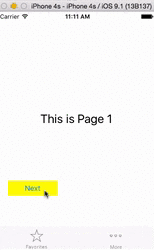Swift iOS: how to trigger next page using buttons
Swift 3.0
Very simple solution is here
To change page (UIViewController) from a UIViewController, first get the instance of Parent ViewController (which will be UIPageViewController) and then set its current ViewController
In my case I have a UIPageViewController named "UserDetailsPVC" and it contains 4 pages (UIViewControllers) which are as follows
PageOneVC:UIViewController
PageTwoVC:UIViewController
PageThreeVC:UIViewController
PageFourVC:UIViewController
In the UIPageViewController lets define an array of pages
var pages:[UIViewController] = [
UIStoryboard(name: "Main", bundle: nil).instantiateViewController(withIdentifier: "PageOneVC"),
UIStoryboard(name: "Main", bundle: nil).instantiateViewController(withIdentifier: "PageTwoVC"),
UIStoryboard(name: "Main", bundle: nil).instantiateViewController(withIdentifier: "PageThreeVC"),
UIStoryboard(name: "Main", bundle: nil).instantiateViewController(withIdentifier: "PageFourVC")
]
Now to change page of UIPageViewController from any of the UIViewController
// get parent view controller
let parentVC = self.parent as! UserDetailsPVC
// change page of PageViewController
parentVC.setViewControllers([parentVC.pages[1]], direction: .forward, animated: true, completion: nil)
Michael Dautermann's answer is perfectly correct, as this screencast shows:

What you're seeing is a page view controller with multiple pages (numbered so you can see the order), each page containing a Next button, and I'm repeatedly pressing the Next button to navigate to the next page.
Like yours, my project, illustrated in the screencast above, has a view controller hierarchy:
UITabBarController
ViewController
UIPageViewController
Page (which has a main view, and the label and buttons are subviews of that)
It appears that the heart of your question is not so much what method causes a page view controller to navigate to its next or previous page — that, as you have already been told, is simply setViewControllers:... — but how the button communicates up the view controller hierarchy. In my example, that means sending a message from the button inside Page's view, past the Page view controller, past the UIPageViewController, and up to the ViewController, which then tells th UIPageViewController what to do.
I can think of numerous ways to do that:
The button posts a notification for which the ViewController is registered
The button sends a nil-targeted action for which the ViewController has a handler
The button sends a message to the tab bar controller (its
tabBarControllerproperty), which then sends a message down to its currently selected view controller, the ViewControllerThe button sends a message to its view controller (configured in the nib or storyboard as an action), which sends a message to its
parentViewController!.parentViewController!, which is the ViewController.
Which do I prefer? Personally, I like the nil-targeted action best, because it requires no extra code. The only func pageNextButton() implementation is in ViewController. That is beauty of a nil-targeted action: it walks up the responder chain, looking for a recipient, automatically. The Page view controller and the UIPageViewController have no code at all in this regard.
I like this much better than parentViewController!.parentViewController!, because the latter requires ultimately that the Page view controller knows the name of a method in the ViewController that it can call, and it must cast down to a ViewController — which is not very portable and gives the Page view controller too much knowledge about its environment, in my opinion. With a nil-targeted action, on the other hand, the sender is totally agnostic about who the actual target will turn out to be! So I like nil-target action best, and notification second best.
You can use setViewControllers:direction:animated:completion: to turn your pages programatically.
Just pass along the previous or next page's view controller and you should be all set.